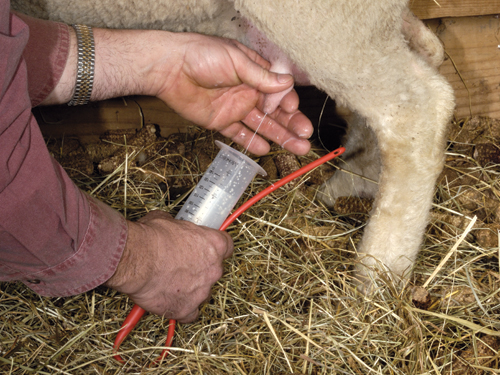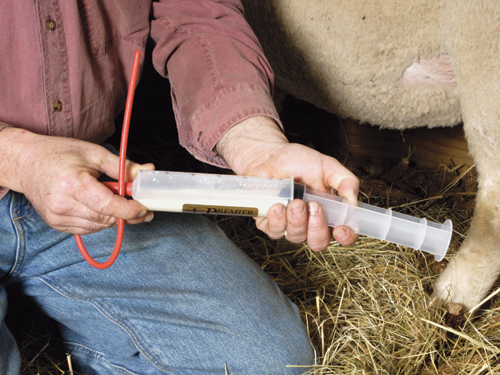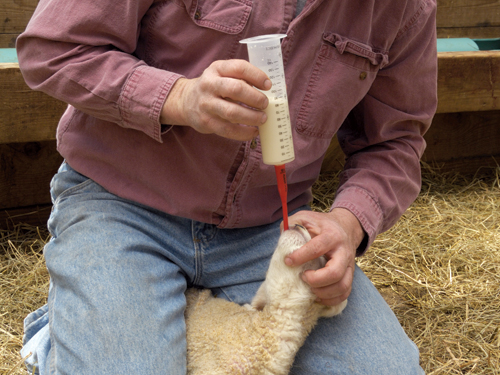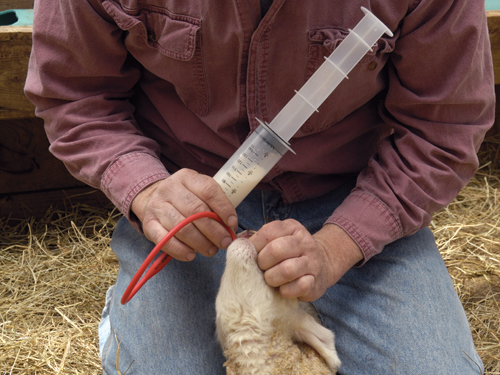During lambing every producer is faced with the problem of feeding lambs suffering from exposure and weakness. Attempts to bottle feed frequently result in fluid entering the air passages because of the lamb’s inability to swallow. No doubt you have felt the bubbling sensation which is a forerunner of death by drowning or pneumonia.
Gains far exceed the cost
For those lambing ewes indoors, few tools return more profit per $$ of invested than “a tuber.”
Cold, tiny or weak lambs and kids that otherwise would die can be saved if you can get warm colostrum into them in time. It is faster and better to “tube” a newborn lamb or kid than to try to feed from a teat and bottle.
Artificial teats are fine for normal/strong lambs/kids, but weak lambs/kids fed via a nipple may inhale milk into their lungs, which can trigger pneumonia.
Practice makes perfect
We know that inserting a tube into a lamb/kid intimidates “newbies.” But the process is not difficult. No force is required. If the lamb or kid shows discomfort, the tube may have entered the windpipe (trachea). If so, remove the tube and try again.
We like to see the tip of the tube slightly expanding the skin of the lamb’s out-stretched neck on its way to the stomach. In larger lambs all but 2″ of tube can be inserted.
A lamb or kid may chew on the tube during the process. That’s OK.
Steps to using a “tuber”

Step #1 - Tubing is easy, but milking colostrum from ewes or does requires strength and patience. We milk directly into a 140cc syringe (instead of a second container) to save time and colostrum. Note the upright “bent tube” to prevent milk loss.

Step #2 - To prevent milk being pushed out by the plunger (or lost while inserting into lambs), carefully tip the syringe to the side and insert the plunger at an angle. Milk will run toward plunger allowing air (and not milk) to escape out the tube as the plunger is inserted.

Step #4 - When the tube is fully in place, remove the plunger and allow milk to flow slowly by gravity into the lamb’s stomach. If no flow occurs, try sliding the tube in and out an inch or two. For very thick colostrum, some use the plunger to very slowly push the milk into the lamb’s stomach. A 10 lb lamb will “digest” up to 40cc an hour. 140cc in the lamb should last about 4 hours.
Tubing advice:
- Do not ram the milk into the stomach with the plunger. We prefer to take the plunger away and let the milk flow in by gravity.
- Never use dirty tubes or syringes. Wash thoroughly after each use.
- Syringes and tubes wear out without warning so buy replacements early.
- Do not tube a lamb or kid that’s too chilled to raise its head. First warm it in a warming box (or similar). After it’s warm, then you can tube it.
- Hypothermic lambs and kids should first have 25 to 50cc of 20% warm glucose injected into the peritoneal cavity. Only when it can raise its head should it be “tubed.”



